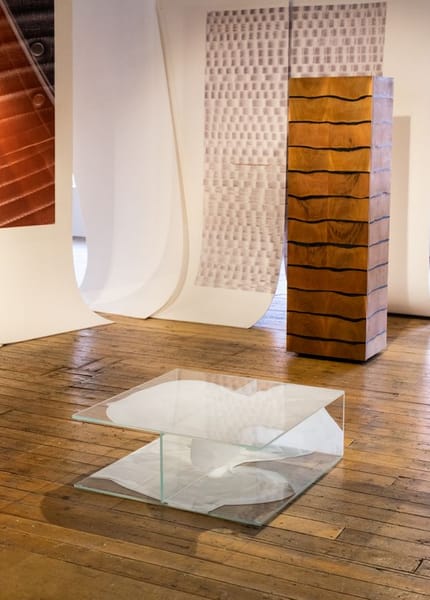Non-Linear – Objects & Ideas From an Associative Design Process
September 2019
Solo-exhibition, Aram Gallery, London 2019
Rotterdam-based Studio Truly Truly (Kate and Joel Booy), design products, lighting, furniture and textiles. For ‘Non-Linear’ at the Aram Gallery, London, the studio reflects on their creative practice and inspirations, identifying an indirect design process. Here, they present a selection of objects addressing the topic of the future living environment, developed for their recent ‘Das Haus’ presentation for the Cologne International Furniture Fair, as well as a new table spawned from recent experimentations with paint and glass. Also on show is one of the studio’s key industrially produced objects for the lighting company Rakumba. In contrast to this, are a number of objects stemming from a process-driven approach which are hand-crafted by the studio. The objects are presented among a dynamic tumble of panels conceived as a representation of the fluid thought-paths and associations of the studio’s creative process. Inspirations and their respective objects are mixed throughout the space, reflecting the way Truly Truly’s ideas cross-pollinate from one project to another and offering a deeper insight into their thinking.
Truly Truly invited photographer Pim Top to create the series of images which represent the starting point for each object. Some are visual stepping-stones that led Truly Truly directly to the objects. This is seen in the pathway leading to their new paint and glass table. However, other images are representations of broader fascinations with material properties. In the photograph for the Levity light, Pim Top needed to create an image that clearly communicated the physical properties of a Canternary curve. Finally, in the studio’s process-driven work, a fascination isn’t the starting point, but rather the object takes shape and is influenced through a process of making. In these circumstances, a key object from the process was photographed, as in the image of the mould for the Touched light.
Themes central to the studio’s work include: accentuating a material’s natural expression, wielding materiality to provoke the senses, and investigating how we experience objects and space. There is a focus on designing thoughtful products for the living environment that combine function with sensuality. Increasingly important to them are objects that are visually simple, but functionally diverse. An example of this is the Glimpse Mirrored Screen which functions seamlessly as a room divider, a mirror and a shelf. This flexibility aims to produce objects that are beautiful like a sculpture, rather than visually complicated like a Swiss army knife, giving rise to the possibility of needing fewer objects. By playing with seating levels and direction, merging typical zones and characterising a space by atmosphere rather than singular function, their recent work promotes flexible spaces to adapt to changing life rhythms.

